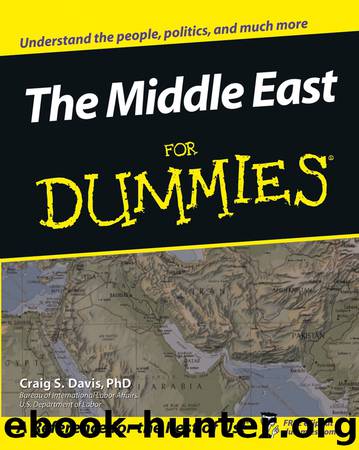The Middle East For Dummies by Craig S. Davis

Author:Craig S. Davis
Language: eng
Format: epub
Publisher: Wiley
The next year more than 100 British captives still held by the tribes were rescued, as well as more than 2,000 Indian soldiers and camp followers. Over time other stragglers made their way back to India.
Afghan tribes, ethnicity, and Pashtunistan
Before proceeding, you need to understand something about the tribal configuration of Afghanistan and Pakistan. Ever wonder why the dual phrase Afghanistan and Pakistan keeps popping up in the news and on TV? Well, news services often reference the two countries together because of the makeup and location of Pashtuns (Pashtu speakers). Pashtu is the first language for about 35 percent of Afghanistan’s population. Pashtuns (who also call themselves Pathans) live in tribal areas on the Afghan side of the Pakistani border and spill over into the Pakistani provinces of the North West Frontier Province and Baluchistan (see Figure 13-2). Besides a common language, these Pashtuns share a common culture and, frequently, religious and political perspectives. Combined, the Pashtuns on both sides of the border constitute a force to be reckoned with.
The Tajiks, speakers of an Afghan dialect of Persian (or Farsi in Iran), called Dari, comprise about half of Afghanistan’s population. Turkmen and Uzbeks speaking Turkic languages account for another 10 percent. Ethnic friction and violence has frequented Afghanistan in the past. Often one ethnic group sought to dominate the others. Whenever the British gave India its independence, India split into two parts: the northwestern chunk, calling itself Pakistan (see Chapter 14), and the remainder, calling itself India. In the 1950s, the Pashtuns in Pakistan and Pashtuns in Afghanistan decided they too wanted a separate nation called Pashtunistan. Their bid for an autonomous region was foiled in the 1960s and then again in the 1970s. Subsequent Pakistani and Afghan governments have been alert to Pashtun discontent that may spill over into secessionist violence.
Figure 13-2: The ethnic divisions within Afghanistan.
Download
This site does not store any files on its server. We only index and link to content provided by other sites. Please contact the content providers to delete copyright contents if any and email us, we'll remove relevant links or contents immediately.
| Africa | Americas |
| Arctic & Antarctica | Asia |
| Australia & Oceania | Europe |
| Middle East | Russia |
| United States | World |
| Ancient Civilizations | Military |
| Historical Study & Educational Resources |
Empire of the Sikhs by Patwant Singh(22763)
The Wind in My Hair by Masih Alinejad(4839)
The Templars by Dan Jones(4557)
Rise and Kill First by Ronen Bergman(4545)
The Rape of Nanking by Iris Chang(4022)
12 Strong by Doug Stanton(3419)
Blood and Sand by Alex Von Tunzelmann(3055)
The History of Jihad: From Muhammad to ISIS by Spencer Robert(2504)
Babylon's Ark by Lawrence Anthony(2428)
The Turkish Psychedelic Explosion by Daniel Spicer(2245)
No Room for Small Dreams by Shimon Peres(2235)
Gideon's Spies: The Secret History of the Mossad by Gordon Thomas(2233)
Inside the Middle East by Avi Melamed(2230)
Arabs by Eugene Rogan(2193)
The First Muslim The Story of Muhammad by Lesley Hazleton(2154)
Bus on Jaffa Road by Mike Kelly(2035)
Come, Tell Me How You Live by Mallowan Agatha Christie(2025)
Kabul 1841-42: Battle Story by Edmund Yorke(1921)
1453 by Roger Crowley(1879)
